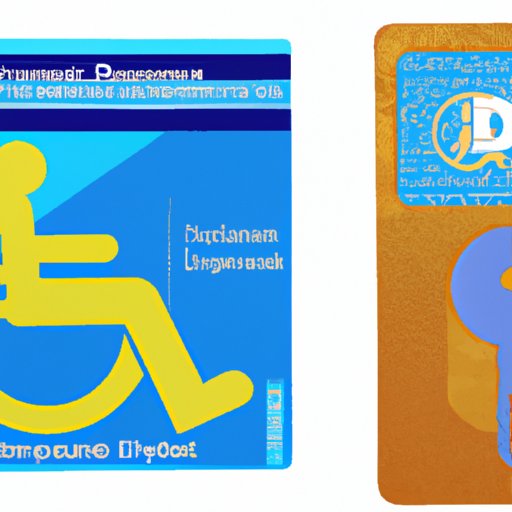
I. Introduction
Handicap placards help individuals with disabilities to easily access parking spaces and special services. In this article, we will provide a detailed guide on how to obtain a handicap placard, the benefits of having one, who can qualify for it, where to apply for it, tips to expedite the process, common mistakes to avoid, and the rules and regulations surrounding its use.
II. Step-by-Step Guide: How to Obtain a Handicap Placard
Obtaining a handicap placard is a simple process that involves requesting it from the relevant authorities. The first step in acquiring a handicap placard is to determine the eligibility criteria and the type of placard you need.
There are different types of handicap placards, including temporary and permanent placards. Temporary placards are valid for up to six months while permanent placards are issued for up to five years.
To apply for a handicap placard, you need to visit your state Department of Motor Vehicles (DMV) office or download the application form online. Before making your application, you will need to gather some documents and information, including:
- Your current driver’s license or identification card
- Medical certification form signed by your physician
- Proof of residency, such as utility bills, vehicle registration, or tax documents
- Application fee, which varies depending on the state
Once you have all the necessary documents, you should complete the application form and submit it to the DMV for processing. Processing times may vary depending on the state where you live and the type of placard you need.
To expedite the process, you can:
- Double-check all the necessary documents
- Fill out the application form correctly
- Be aware of any changes in the application process
III. Benefits of Having a Handicap Placard
Having a handicap placard comes with numerous advantages that make it easier for individuals with disabilities to access public spaces and services. Some of the benefits of having a handicap placard include:
- Easier access to parking spaces, which are usually located closer to the entrance
- Reduced walking distance, which is helpful for individuals with mobility issues
- Access to special services, such as wheelchair ramps and elevators
Handicap placards can be useful in various real-life scenarios, such as:
- Going to the grocery store
- Visiting a doctor’s office
- Attending a concert or sporting event
IV. Who Can Qualify for a Handicap Placard?
Individuals with disabilities who meet specific medical criteria can qualify for a handicap placard. Medical conditions that qualify include but not limited to:
- Heart conditions
- Lung disease
- Mobility limitations or use of mobility aids
- Visual impairments
- Nervous system disorders
To prove that you have a qualifying medical condition, you need to provide your physician with the Medical Certification for Disability & Special License Plates or Parking Placards form. This form should be completed and signed by a licensed physician.
Temporary handicap placards are issued for individuals who have a temporary disability, and usual validity period is 3 to 6 months, depending on the state.
V. Where to Apply for a Handicap Placard
Handicap placards can be applied through various channels, including online, by mail, or physically visiting the DMV.
To apply for a handicap placard online, visit the DMV website in your state and look for the application section. The website will guide you through the process of filling out the application form and uploading any required documents. This method is the quickest and most convenient way to apply for a handicap placard.
Alternatively, some states allow applicants to apply for a handicap placard by mail. Contact your local DMV office or visit their website to acquire the application form.
Walking into the DMV office to submit the application and any necessary documents is another option. This method can be helpful if you have any questions or concerns regarding the application process.
VI. Tips for Faster Processing
To ensure a smoother and faster application process, follow these tips:
- Double-check required documents before submitting the application
- Fill out the application form correctly and completely
- Be aware of any changes in the application process
Some common reasons for delays in processing handicap placard applications include:
- Missing or incorrect documents
- Incorrect application form
- Submitting the application to the wrong department
VII. Common Mistakes to Avoid
Here are some common mistakes that applicants make when applying for a handicap placard:
- Submitting an incomplete application form
- Using an outdated version of the application form
- Not providing adequate medical information
- Not renewing the placard on time
- Misusing the placard by allowing another person to use it or parking it in a reserved space when you do not need it
By avoiding these mistakes, you increase your chances of getting a handicap placard quickly and efficiently.
VIII. Understanding the Rules & Regulations
It is essential to understand the rules and regulations surrounding the use of a handicap placard to avoid consequences. Here are some of the fundamental rules and regulations you need to know:
- Handicap placards must be displayed on the rearview mirror when parked in a handicap spot
- Only the person who is issued the handicap placard can use it.
- If using someone else’s handicap placard, they have to accompany you in the vehicle and you cannot park in a handicap parking spot without them.
- Unauthorized use of a handicap placard carries fines and penalties, and the placard may be revoked.
IX. Conclusion
Obtaining a handicap placard is a simple and straightforward process, which involves submitting an application form with the necessary documents. Ensure that you follow the instructions in this guide to avoid any mistakes or delays in the application process. By having a handicap placard, individuals with disabilities will have access to convenient parking spaces and services, making their daily lives more manageable and enjoyable.
For more information, visit your local DMV office or check the DMV website in your state.




